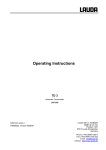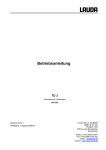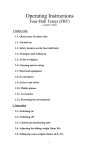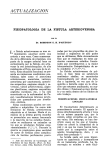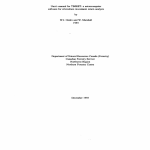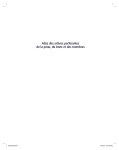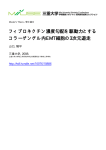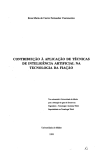Download Operating Instructions
Transcript
Operating Instructions Ring/Plate-Tensiometer TD 1C 06/05 TD 1C_E LAUDA DR. R. WOBSER GMBH & CO. KG P.O. Box 1251 97912 Lauda-Königshofen Germany Phone: (+49) (0) 9343/ 503-0 Fax: (+49) (0) 9343/ 503-222 e-mail [email protected] Internet http://www.lauda.de Ring/Plate Tensiometer TD 1C CONTENT Chapter Page 1 INTRODUCTION 1.1 Short description and applications 1.2 Operating principle 2 COMPONENTS AND INSTALLATION 2.1 Measuring stand 2.2 Control panel Command 2.3 Setting up the TD 1C 2.4 Command control functions 2.4.1 2.4.2 2.4.3 2.4.4 2.4.5 2.4.6 3 TESTING SURFACE TENSION 3.1 Using the plate 3.1.1 3.1.2 3.1.3 3.1.4 3.1.5 3.2 3.3 Checking and Setting ring parameters Preparation of measurement Taring Calibrating Performing a ring measurement The display of measured surface /interface tensions 3.3.1 3.3.2 Plate measurement Ring measurement MEASURING DENSITY AND WEIGHT 4.1 Density measurement 4.1.1 4.1.2 4.1.3 4.1.4 4.1.5 4.2 Setting of parameters Preparation of measurement Taring Calibrating Performing a density measurement Weight measurement 4.2.1 4.2.2 4.2.3 4.2.4 4.2.5 2 Preparation of measurement Checking and Setting plate parameters Taring Calibrating Performing the plate measurement Using the ring 3.2.1 3.2.2 3.2.3 3.2.4 3.2.5 4 Description of keys. Main Menu Sub-Menu „Experiment New“ Sub-Menu „Experiment View“ Sub-Menu „Settings“ Sub-Menu „Tools“ Setting of parameters Preparation of measurement Taring Calibrating Performing a weight measurement 5 5 5 6 6 7 9 10 10 12 12 13 13 14 14 14 14 15 16 17 18 18 19 19 20 21 23 24 24 25 26 26 26 27 27 27 29 31 31 31 31 32 33 Ring/Plate Tensiometer TD 1C 5 VIEWING MEASURED RESULTS 5.1 Results overview 5.2 View of details 6 APPENDIX 6.1 Reference values for checking the TD 1C 6.2 Cleaning test glasses and materials used 6.2.1 6.2.2 6.3 Platinum test bodies Test glasses and glass body Literature references 34 34 35 36 36 36 36 36 37 3 Ring/Plate Tensiometer TD 1C 1 Introduction This instruction provides you the necessary information about the use of the TD 1C 1.1 Short description and applications The LAUDA automatic Tensiometer TD 1C consists of the measuring stand and the COMMAND unit and is used for measuring surface and interfacial tension, for determining liquid density, as well as for measuring weights. In contrast with other instruments of this type the TD 1C has been specially developed as a low cost easy to handle measuring device to combine high-quality measurement system with documentation and represents an interesting and less expensive alternative to automatic systems. The TD 1C is particularly suitable for: • universities, colleges, teaching institutes and other educational establishments, • industrial and quality control laboratories • research and development departments There is a wide range of applications, including: • evaluating and testing of physical properties of the above types on organic and inorganic liquids, solutions, liquid/liquid and liquid/solid dispersions emulsions etc. • development and testing of surfactants (detergents emulsifiers etc.) and their detection in effluents and streams. The combination of precision weighing technology with a high- performance electronic system provides for a wide range of measurements using a variety of test bodies. For surface and interfacial tension measurement these are: • platinum/iridium plate after Wilhelmy • platinum/iridium ring according to ASTM D 971 and DIN 53914 and for density measurement: • glass displacement plunger By using an optional jacketed vessel (incl. cover) to take the sample beaker it is possible to operate the system over a wide temperature range with the aid of a LAUDA thermostat e.g. of type ECOLINE, RE104 It is strongly recommended to read this manual carefully prior to power-up the TD 1C! 1.2 Operating principle Determination of the surface or interfacial tension with a plate or ring consists of measuring the vertical force which the surface or interface of the liquid exerts on the test body. For this purpose the TD 1C incorporates a manual driven sample stage which permits upward and downward movement of the test liquid without any vibration. After defining the measuring parameters and the measuring method the movement of the table is started manually by turning a knob. In case of ring method the mechanism allows for automatic detection of the maximum force. In case of plate, the sample table has to be brought into first contact of the plate with the sample and stopped. The surface tension values appear immediately including all corrections on the high resolving screen of the COMMAND and can be stored or printed out buy pushing a buttton. The measurement of this force requires an extremely sensitive force cell which is the core element of the TD 1C. 5 Ring/Plate Tensiometer TD 1C Displacement free force measurement is achieved by electro- magnetic compensation of the force transmitted by the test body to a measuring beam. The current required to do this is directly proportional to the force. The value obtained by current / voltage conversion is shown in a table of the COMMAND LCD-screen. Determination of the weighing beam position is achieved by an optoelectronic detector. In addition up to 500 results can be stored within the internal memory of the COMMAND unit and printed out immediately or later. 2 2.1 Components and Installation Measuring stand The measuring stand is equipped with a high-resolution load cell and an sample stage smoothly movable by an adjusting knob. The easily accessible sample chamber allows the use of standard sample beakers up to 8 cm in diameter including temperable sample vessels. Load Cell Du Noüy Ring Movable stage with sample beaker Adjusting knob for sample stage Control Unit COMMAND Fig. 1. 6 Front View and description of main components Ring/Plate Tensiometer TD 1C C A N - P o r t fo r COMMANDM o d u le R S 2 3 2 fo r P ro to c o l p rin te r (O p t) N O P C -c o n n e c t o r ! E x te r n a l P o w e r s u p p ly Fig. 2 2.2 Rear side of TD 1C with electrical connections to accessory components Control panel Command This convenient control panel allows the complete operation, input of measuring parameters, start of measurement and transfer of data to a printer or to internal storage. The high-resolution graphical display offers menu-based user guidance and displays individual measurements and results in tabular format. 7 Ring/Plate Tensiometer TD 1C LCD-Screen Navigation keys Measurement Start/Stop Dual SoftKeys Fig. 3 Parts of the COMMAND-unit Actual command Status line Device status TD 1C ok Free internal memory Free432 Main window Soft key functions LAUDA DR. R. WOBSER GMBH & CO.KG 97912 Lauda-Koenigshofen Germany 16.07.04 11:02:16 MENU Fig. 4 8 HELP Segmentation of the LCD Screen. Here the information screen immediately after switching on is shown, Ring/Plate Tensiometer TD 1C 2.3 Setting up the TD 1C The following points should be observed when setting up the tensiometer: 1. Select its location on an accurately horizontal table so that any effect of building vibrations is largely excluded. 2. Check that the voltage marked on the back of the external power unit agrees with the local supply voltage 3. Plug-in the supply cable coming from external power supply into the COMMAND 4. Plug-in COMMAND cable to the TD 1C measuring stand. 5. Plug-in the power supply cable into the mains socket. Before doing this take care that the mains switch of the external power supply should be set to 'OFF'. 6. The optional printer is connected at the back (9-pole) of TD 1C Note: this Connector is ONLY for the printer NOT for data transfer to PC 7. After checking all connections the TD 1C can be switched on at external power supply. The information screen appears (Fig. 3) 8. Take off the plastic tube carefully which is clamped between sample table and transducer housing to protect the measuring system and the hook. Therefor the table is moved down turning the adjusting knob. 9 Ring/Plate Tensiometer TD 1C Command control functions 2.4.1 Description of keys. Command Key Pad Enter Key , confirmation of the selection and/or accepting the changes. Escape Key: 1. to get back to previous screen without accepting the changes at menus “Measurement Parameters”, “Settings” and “Tools” 2. interrupts taring and calibration without changes Menu navigation keys: up/down 1. to select menu items up and down 2. to increment/decrement numerical values of parameters Menu navigation keys (left/right) 1. To switch between selection menus: Right: first item of the sub-menu is selected Left: last item of the main menu is selected 2. Select letter/digit of parameters Duo keys above: decimal point key below: minus sign (not used) Soft keys 5 keys, which have the functions shown in the display above. Soft key inputs are marked in the manual with a frame. Example: To print the results, press the duo key below PRINT . If NOT illuminated, the preselected measurement will be started from measurement screen. If illuminated, the measurement is running By pressing the key the measurement will be stopped immediately. The evaluation will be done over the last completed cycles. 10 Ring/Plate Tensiometer TD 1C Soft Keys at Start and “Main menu” screen MENU Screen switches to the Main Menu (Fig.3) HELP Not available yet Soft Keys at Result Screen MENU Screen switches to the Main Menu (Fig.4) SAVE The data of the result line, together with the numerical sample ID code, and measurement parameters are saved in the internal memory of the COMMAND. Max. 500 sets can be stored. The free number of sets is displayed in the status line of the result screen (here: Free432) PRINT The data of the result line, together with the numerical sample ID code, and measurement parameters will be printed out at the protocol printer. NEW Defines a new measurement followed by the menu “Experiment new” opens 11 Ring/Plate Tensiometer TD 1C 2.4.2 Main Menu TD 1C ok Experiment new Experiment view Settings Tools After entering MENU the main menu opens which enables the selection of following sub menus using the navigation keys: Free432 Density Plate Ring Weight Experiment new: Selection of measuring mode for a new measurement Experiment view: Viewing results of previously saved measurements Settings Defining and changing important base settings concerning date ,display, language ABOUT HELP Tools test functions for system and printer. Memory cleaning 2.4.3 Sub-Menu „Experiment New“ TD 1C Experiment new Experiment view Settings Tools ok After selecting Experiment new and confirmation the corresponding Sub-Menu opens, where following modes can be selected: Free432 Density Plate Ring Weight Density Enables determination of density of liquids by measuring buoyancy using a displacement plunger Plate Surface/Interface tension measurement using Wilhelmy method Ring Surface/Interface tension measurement using du Noüy method ABOUT 12 HELP Weight Measurement of small weights (max. 5g) Ring/Plate Tensiometer TD 1C 2.4.4 Sub-Menu „Experiment View“ TD 1C ok Experiment new Experiment view Settings Tools Free432 After selecting Experiment view by cursor the results of experiments of the different modes can be displayed. Density Plate Ring Weight ABOUT HELP 2.4.5 Sub-Menu „Settings“ TD 1C Experiment new Experiment view Settings Tools ok Calendar A date can be entered or modified Free432 Calendar Clock Display brightness Display contrast Language Acoustic signal Date view format Clock A time can be entered or modified Display brightness can be modified in 8 levels Display contrast can be modified in 8 levels Language English or German language can be selected Acoustic signal Loudness can be adjusted in 4 steps ABOUT HELP Date view format DD.MM.YY or MM.DD.YY can be selected 13 Ring/Plate Tensiometer TD 1C 2.4.6 Sub-Menu „Tools“ TD 1C ok Experiment new Experiment view Settings Tools Free432 Selftest Keyboard test Data memory clean Self test Results of the self test, always performed after switching on is displayed, showing system information and the status CPU and RAMs Keyboard test Is a functional test of all keys of the COMMAND module Data memory clean To erase all stored results ABOUT 3 3.1 HELP Testing surface tension Using the plate 3.1.1 Preparation of measurement The following preparation is required for this measurement: 9 The TD 1C is switched on by means of the external power supply switch 9 Use adjusting knob to move the table in a position giving space enough for changing of beakers and to attach the plate 9 The plate supplied is attached to the hook of the measuring system. Ensure that the plate has no contact with the test liquid. 14 Ring/Plate Tensiometer TD 1C 3.1.2 Checking and Setting plate parameters Select “Experiment new”. After confirmation the sub-menu “New Plate exp” opens: MENU -> Experiment new ->Plate ↵ New plate exp. ok Measuring parameters Plate parameter set Tare Calibrate L The exact length of the plate has to be entered. Here the values of the accessory plate, according DIN 53914, is shown. It can be adjusted between 10 and 30 mm in case of deviations or other. Free432 L = 19.90 mm D = 0.10 mm D The exact thickness of the plate has to be entered. Here the value according DIN53914 is shown, which is appropriate to the accessory plate. It can be adjusted between 0.05 and 0.5 mm in case of deviations or other plates are being used. MENU New plate exp. ok Measuring parameters Plate parameter set Tare Calibrate MENU HELP Free432 Q Exp.ID = 123 Exp.ID A numerical value (max. 3 digits) can be assigned by using soft keys to the sample HELP 15 Ring/Plate Tensiometer TD 1C 3.1.3 Taring The probe weight has to be tared prior to the first measurement or in case of the measuring probe being changed before the plate touches the liquid by using the function “Tare” in the “New plate exp.” -menu New plate exp. ok Measuring parameters Plate parameter set Tare Calibrate Free432 Q Stable Unstable Very unstable Stable Has to be selected if the surrounding is very stable and free of vibrations or winds. Unstable / Very Unstable Has to be selected if a taring in mode Stable (Unstable) is not possible because of outer conditions. Note that reproducibility of results will eventually be reduced. MENU New plate exp. HELP ok Free432 Q If no successful taring is possible in mode “very unstable” the instrument has to be moved to a more disturbation free position. Taring in progress This message appears when taring is executed Do not disturb this process. Prevent system from vibrations Taring in progress Taring successful This message appears after completing the taring procedure. Confirm to switch the screen back to previous sub menu. Taring can be interrupted using 16 Ring/Plate Tensiometer TD 1C 3.1.4 Calibrating A calibration check should be done with accessory calibration weights prior to the first measurement and in case the measuring probe has been changed,. New plate exp. ok Measuring parameters Plate parameter set Tare Calibrate Stable Has to be selected if the surrounding is very stable and free of vibrations or winds. Free432 Stable Unstable Very unstable Unstable / Very Unstable Has to be selected if a taring in mode Stable (Unstable) is not possible because of outer conditions. Note that reproducibility of results will eventually be reduced. MENU HELP New plate exp. ok Calibration weight, mg The precise weight of the calibration stirrup has to be entered using the Duo-soft keys now assigned with digits Free432 Calibration weight,mg Therefore the corresponding digit has to be selected and changed via soft key. The digits can be incremented or decremented using or 500.01 Min 490 00 If no successful taring is possible in mode “very unstable” the instrument has to be moved to a more disturbation free position. In this case the last digit was changed into „1“, according to the precise weight of the stirrup (500.01 mg). With ↵ calibration is started. Max:510 00 1 2 3 4 5 6 7 8 9 0 Calibration has to be done as follows 1. The 500 mg calibration weight supplied is attached to the hook in addition to the plate. 2. Exact weight is entered. 17 Ring/Plate Tensiometer TD 1C 3. After ↵ the calibration starts with the following message: New plate exp. ok Free432 Calibrating in progress This message appears during the calibration Do not disturb or interrupt this process. Prevent system from vibrations Calibrating in progress Calibration successful This message appears once the calibration procedure is completed . Confirm to switch the screen to the previous sub menu. Calibration can be interrupted using 4. After confirmation (↵) the calibration weight is removed. If not successful , the calibration have to be repeated. 3.1.5 Performing the plate measurement A measurement with the plate is performed in the following steps: 1. The sample table is moved down by adjusting knob and the test liquid in the beaker supplied is placed on the table. 2. The sample table with the liquid is moved up carefully. 3. If the force sensor feels the contact with the liquid surface or interface the movement has to be stopped. stops. Immediately on contact with the surface the display shows a jump of the force value. This value is the absolute surface/interface tension in 'mN/m'. 4. The force values and the evaluated surface tension is shown in the result screen (see below) Note that this value is correct only if the plate is completely wetted, i.e. a uniform meniscus can be observed at the bottom end of the plate and the liquid film on the plate shows no visible non-uniformities. - 3.2 Using the ring Unlike in the case of the plate, measurement with the ring does not show a direct proportionality between measured force and surface /interface tension, because of the lamella drawn up with the ring the measurement includes a weight in addition to the surface tension. Further information on ring measurement and its correction can be found in the following publications: Du Noüy, P. L.,: J. Gen. Physiol. New York, 1(1919), S.521 Harkins, M. + Jordan H. : J. Am. Soc. 52 (1930), S.I 751 Zuidema, H. + Waters C. W. : Ind. Eng. Chem. Analyt. 13 (1941), S.312 Fox, H. W. + Chrisman C. H.: J. phys. Chem. 56 (1952), S.284 In addition reference should be made to the literature reference section attached. 18 Ring/Plate Tensiometer TD 1C 3.2.1 Checking and Setting ring parameters MENU -> Experiment new -> Ring ↵ New ring exp. ok Measuring parameters Ring parameters Tare Calibrate R The exact radius of the horizontal ring has to be entered. Here the (default) value according DIN 53914 is shown, which is appropriate to the accessory ring. It can be adjusted to the real dimensions between 9.00 and 9.99 mm in case of deviations or a ring with other dimensions is used. Free432 R = 9.55 mm r = 0.20 mm MENU HELP r The exact radius ( = diameter/2) of the wire has to be entered. Here the (default) value according DIN 53914 is shown, which corresponds to the accessory ring. It can be adjusted between 0.10 and 0.30 mm in case of radius changes (i.e. by corrosion or coatings) or a ring with different wire is being used. 3.2.2 Preparation of measurement 1. Use adjusting knob to move the table in a position giving space enough for changing of beakers and to attach the ring 2. The ring supplied is attached to the hook of the measuring system without any contact with the test liquid surface or in case of interface tension dipped into the lower phase without any contact to the interface. (this has to be done before pouring the upper phase on top) 3. Select Experiment new -> Ring”. After confirmation the sub-menu “New Ring experiment” opens: 19 Ring/Plate Tensiometer TD 1C New ring exp. ok Measuring parameters Ring parameters Tare Calibrate MENU Exp.ID A numerical value (max. 3 digits) can be assigned by using soft keys to characterize the sample Free432 Exp.ID = 123 ∆ρ = 0.99 g/cm³ ∆ρ The density, in case of surface tension or density difference (in case of interface tension) has to be entered here. This value is needed for the automatical ring correction according Zuidema & Waters. For diluted aqueous solutions a value of 0.99 g/cm³ at room temperature (18-25°C) is sufficient. HELP 3.2.3 Taring The probe weight has to be tared prior to the first measurement or in case of the measuring probe being changed before the ring touches the liquid by using the function “Tare” in the “New ring exp.” - 20 Ring/Plate Tensiometer TD 1C New ring exp. ok Measuring parameters Plate parameter set Tare Calibrate Stable Has to be selected if the surrounding is very stable and free of vibrations or winds. Free432 Stable Unstable Very unstable Unstable / Very Unstable Has to be selected if a taring in mode Stable (Unstable) is not possible because of outer conditions. Note that reproducibility of results will eventually be reduced. MENU New ring exp. HELP ok Free432 Q If no successful taring is possible in mode “very unstable” the instrument has to be moved to a more disturbation free location. Taring in progress This message appears during the calibration Do not disturb this process. Prevent system from vibrations Taring in progress Taring successful This message appears once the calibration procedure is completed . Confirm to switch the screen to the previous sub menu. Taring can be interrupted using 3.2.4 Calibrating A calibration check should be done prior to the first measurements and in case the measuring probe is changed by using accessory calibration weights. 21 Ring/Plate Tensiometer TD 1C New ring exp. ok Measuring parameters Plate parameter set Tare Calibrate Stable Has to be selected if the surrounding is very stable and free of vibrations or winds. Free432 Stable Unstable Very unstable Unstable / Very Unstable Has to be selected if a taring in mode Stable (Unstable) is not possible because of outer conditions. Note that reproducibility of results will eventually be reduced. MENU HELP New ring exp. ok Calibration weight, mg The precise weight of the calibration stirrup has to be entered using the Duo-soft keys now assigned with digits Free432 Calibration weight,mg Therefore the corresponding digit has to be selected and changed via soft key. The digits can be incremented or decremented using or 500.01 Min 490 00 If no successful taring is possible in mode “very unstable” the instrument has to be moved to a more disturbation free position.! In this case the last digit was changed into „1“, according to the precise weight of the stirrup (500.01 mg). With ↵ calibration is started. Max:510 00 . 1 2 3 4 5 6 7 8 9 0 Calibration is performed as follows: 1. The 500 mg calibration weight supplied is attached to the hook in addition to the ring. 2. Exact weight is entered. 3. After ↵ the calibration starts with the following message: 22 Ring/Plate Tensiometer TD 1C New ring exp. ok Free432 Calibrating in progress This message appears during the calibration Do not disturb this process. Prevent system from vibrations Calibrating in progress Calibration successful This message appears once the calibration procedure is completed . Confirm to switch the screen to the previous sub menu. Calibration can be interrupted using 4. After confirmation (↵) the calibration weight is removed. If not successful , the procedure has to be repeated. 3.2.5 Performing a ring measurement A measurement with the ring is performed in the following steps: 1. The sample table is moved down by turning adjusting knob to the a low position, to allow the change of sample beaker. 2. The test liquid in a sample beaker (different sizes possible) is placed on the table. 3. The ring supplied with the equipment is attached to the hook of the measuring system. 4. The table with the liquid is moved up again until the ring is at least 2 - 3 mm below the liquid surface. 5. Only in case of interface tension:: The second lighter phase (Oil) is poured carefully on top of the heavier phase (water) until the sheet gets a thickness of about 1 cm. Be sure that during this the liquid surface is not disturbed and the ring does not to touch the oil. 6. For the test the table has to be moved downwards carefully and a lamella attached to the ring is shown 7. The force displayed at COMMAND will increase until a maximum is reached. 8. The passing the maximum and the detection of it is marked by a “beep” 9. The movement has to be stopped, if possible before detachment of lamella. 10. The surface tension calculated from the measured maximum force is displayed and can be stored or printed out. 11. The correction factor for the ring is calculated by the COMMAND software according to Zuidema & Waters. 23 Ring/Plate Tensiometer TD 1C 3.3 The display of measured surface /interface tensions 3.3.1 Plate measurement Before plate touches the sample), New plate exp. 0 mg Free432 σ, mN/m 0.0 σ, mN/m After touching the liquid New plate exp. here the surface tension calculated from the actual measured force is displayed. 932 mg Free432 Please note: σ, mN/m This value corresponds to the real surface tension of sample if the plate just touches the surface without dipping in and if the plate is perfectly wetted. 72.0 Note: take sure by thoroughly cleaning that wetting of plate is optimum. To get the “static” equilibrated surface/interface tension it has to be waited until this value will become stable. MENU NEW SAVE PRINT This result at each time can be saved using SAVE into internal storage or printed out using PRINT together with sample ID and parameters For the next measurement with the plate use “NEW” If the measuring mode has to be changed go back via “MENU” 24 Ring/Plate Tensiometer TD 1C 3.3.2 Ring measurement before ring is in contact with the sample) and after dipping in Ring exp. running 0 mg Free432 σ, mN/m 0.0 σ, mN/m During extraction form the liquid Ring exp. running 476 m σ, mN/m Free432 here the wetting force of the lamella units of mN/m tension calculated from the actual measured force is displayed. Please note: 34.7 As long no “beep” sound can be heart and the values still increasing by lowering the table this value does not corresponds to the real surface tension of sample.. After “beep” measurement has to be stopped using again . to get the result. 25 Ring/Plate Tensiometer TD 1C After stop of the measurement (detecting the maximum) Exp. end:user 476 m Free432 Following message appears in status line: “Exp. end: user” Buttons for saving and storing appear After “ σ, mN/m σ, mN/m here the surface tension calculated from the detected maximum force is displayed and should correspond to the surface tension. 72.0 MENU NEW This result can be saved using SAVE into internal storage or printed out using PRINT together with sample ID and parameters SAVE PRINT For the next measurement with the plate use “NEW”. If the measuring mode has to be changed go back via “MENU” 4 Measuring density and weight 4.1 Density measurement 4.1.1 Setting of parameters MENU -> Experiment new -> Density ↵ opens the following „Measuring Parameter menu: where the conditions for the test have to be specified. New density exp. Meas. parameter Tare Calibrate MENU 26 ok Exp.ID A numerical value (0-999) can be assigned by using soft keys to characterize the sample Free432 Exp.ID = 815 HELP Ring/Plate Tensiometer TD 1C 4.1.2 Preparation of measurement The following preparation is required for this measurement: 1. The dry and clean accessory plunger is attached to the hook of the measuring system. 2. Select a sample beaker or bottle which is deep enough that the plunger can be submerged completely into sample or pure water (in case of calibration) without touching the bottom. 3. The table is moved down as far as possible using adjusting knob. 4. The test glass filled with sample or water is placed onto the table without touching the plunger 4.1.3 Taring The plunger weight has to be tared in air prior to the first measurement in case of being by using the New densityorexp. okthe plunger Free432 function “Tare” in the “New density exp.” –menu Measuring parameters Stable Tare Unstable Calibrate Very unstable Stable Has to be selected if the surrounding is very stable and free of vibrations or winds. Unstable / Very Unstable Has to be selected if a taring in mode Stable (Unstable) is not possible because of outer conditions. Note that reproducibility of results will eventually be reduced. If no successful taring is possible in mode “very unstable” the instrument has to be moved to a more disturbation free position. MENU HELP New density exp. ok Free432 Taring in progress This message appears during the calibration Do not disturb this process. Prevent system from vibrations Taring in progress Taring successful This message appears once the calibration procedure is completed . Confirm to switch the screen to the previous sub menu. Taring can be interrupted using 4.1.4 Calibrating A calibration check should be done before the first measurements and always if the measuring probe is changed. This has to be done using distilled water as reference liquid 1. The plunger is fully immersed in the distilled water by moving the table up using adjusting knob 27 Ring/Plate Tensiometer TD 1C New density exp. ok Measuring parameters Tare Calibrate Stable Has to be selected if the surrounding is very stable and free of vibrations or winds. Free432 Stable Unstable Very unstable Unstable / Very Unstable Has to be selected if a taring in mode Stable (Unstable) is not possible because of outer conditions. Note that reproducibility of results will eventually be reduced. MENU HELP New density exp. ok Calibrate density, g/l The precise density of the calibration liquid (water) has to be entered Free432 Calibrate density,g/l Therefore the corresponding digit has to be selected and changed via soft key. The digits can be incremented or decremented using or 997.00 Min: 900.00 1 2 6 7 With ↵ calibration is started. 3 4 5 8 9 0 Density [g/l] 15 998 16 - 22 997 23 - 26 996 27 - 29 995 30 - 33 994 33 - 35 993 28 In this case the default value was changed to the precise density of water at the measuring temperature (table see below) e.g. 997.00 g/l at 20°C. Max: 999.00 Temperature [°C ] If no successful taring is possible in mode “very unstable” the instrument has to be moved to a more disturbation free position. In this table the commonly used density values of pure water are shown. Because of restricted accuracy of the buoyancy the reference density has to be entered only with 3 significant digits. Ring/Plate Tensiometer TD 1C The calibration starts with the following message: New density exp. ok Free432 Calibrating in progress This message appears while the calibration procedure is running. Do not disturb this process. Prevent system from vibrations Calibrating in progress Calibration successful This message appears once after finishing the calibration procedure is completed. Confirm to switch the screen to the previous sub menu. Calibration can be interrupted using The table is moved down again until the plunger is released. The test glass with water is removed from the TD 1C and the plunger is thoroughly cleaned and dried. 4.1.5 Performing a density measurement A density measurement is performed in the following steps: 1. The table with the sample moved up using adjusting knob 2. The motion has to be stopped in the moment where the top of the plunger is at least 3 mm below the liquid surface. 3. If all preparations are complete the force measurement is started by pushing: Measurement is performed automatically until the maximum time and/or the user defined stability criterion is reached. 29 Ring/Plate Tensiometer TD 1C During measurement running:: Density running. 997 During measuring of the density 100 single force values are measured approx. ca. 2 seconds while the mean value and standard deviation are calculated.. Free432 Density (ρ), g/l: Than the measurement will be stopped by the system (Exp.end: Time) 997 Exp.end: user 997 After stop of measurement the density measurement is displayed in the result window. Free432 Density (ρ), g/l: This result can be printed via the external printer using the appropriate Soft-Keys. Alternatively the data can be stored in the internal memory. 997 MENU 30 NEW SAVE PRINT Ring/Plate Tensiometer TD 1C 4.2 Weight measurement 4.2.1 Setting of parameters MENU -> Experiment new -> Weight ↵ opens the following „Measuring Parameter menu: where the conditions for the test have to be specified. New weight exp. Meas. parameter Tare Calibrate ok Exp.ID A numerical value (0-999) can be assigned by using soft keys to characterize the sample Free432 Exp.ID = 815 MENU HELP 4.2.2 Preparation of measurement The following preparation is required for this measurement: 1. The table is moved down far enough to mount the holder for the material to be measured at the hook. 2. The actual weight of the hook together with the holder has to be tared. 4.2.3 Taring Taring has to be done prior to the first measurement using the function “Tare” in the “New weight exp.” – menu New weight exp. ok Measuring parameters Tare Calibrate Stable Has to be selected if the surrounding is very stable and free of vibrations or winds. Free432 Stable Unstable Very unstable Unstable / Very Unstable Has to be selected if a taring in mode Stable (Unstable) is not possible because of outer conditions. Note that reproducibility of results will eventually be reduced. If no successful taring is possible in mode “very unstable” the instrument has to be moved to a more disturbation free position. MENU HELP 31 Ring/Plate Tensiometer TD 1C New weight exp. ok Taring in progress This message appears during the calibration Free432 Do not disturb or interrupt this process. Prevent system from vibrations Taring successful This message appears once the calibration procedure is completed . Confirm to switch the screen to the previous sub menu. Taring in progress Taring can be interrupted using 4.2.4 Calibrating A calibration check should be done before the first measurements and always if the measuring probe is changed using accessory calibration weights. New weight exp. ok Measuring parameters Plate parameter set Tare Calibrate Stable Has to be selected if the surrounding is very stable and free of vibrations or winds. Free432 Stable Unstable Very unstable Unstable / Very Unstable Has to be selected if a taring in mode Stable (Unstable) is not possible because of outer conditions. Note that reproducibility of results will eventually be reduced. MENU 32 HELP If no successful taring is possible in mode “very unstable” the instrument has to be moved to a more disturbation free position. Ring/Plate Tensiometer TD 1C New weight exp. ok Calibration weight, mg The precise weight of the calibration stirrup has to be entered using the Duo-soft keys now assigned with digits Free432 Calibrate weight, mg: Therefore the corresponding digit has to be selected and changed via soft key. The digits can be incremented or decremented using or 499.77 Min: 490.00 In this case the last digit was changed into „7“, according to the precise weight of the stirrup (499.77 mg). With ↵ calibration is started. Max: 510.00 1 2 3 4 5 6 7 8 9 0 After ↵ the calibration starts with the following message: New weight exp. ok Free432 Calibrating in progress This message appears while the calibration procedure is running. Do not disturb or interrupt this process. Prevent system from vibrations Calibrating in progress Calibration successful This message appears once after finishing the calibration procedure is completed. Confirm to switch the screen to the previous sub menu. Calibration can be interrupted using . The calibration weight is removed from the TD 1C 4.2.5 Performing a weight measurement A weight measurement is performed in the following steps: 1. The probe to be measure in to the holder attached or attached directly to the hook of the measuring 2. If all preparations are complete the measurement is started by pushing: 33 Ring/Plate Tensiometer TD 1C During measurement running:: Weight running. 125 During measuring of the weight the actual value is displayed. Free432 The measurement can be stopped by the user (Exp.end: user) Weight, mg/l: 125 Result screen for weight test: Exp.end: user 125mg After stop of measurement the weight measurement is summarized in the result window. Free432 Weight, mg/l: These data can be printed via the external printer using the appropriate Soft-Keys. Alternatively the data can be stored in the internal memory. 125 MENU 5 5.1 NEW SAVE PRINT Viewing measured results Results overview MENU -> Experiment view -> {Method} ↵ Opens the following „View {method} exp.: where all end results of the selected method (ring, plate, density or weight) are shown in the following way: 34 Ring/Plate Tensiometer TD 1C Result overview screen for ring experiments View ring exp. overview Mem 5 6 7 8 12 15 16 17 20 Time 11:10:33 11:15:58 11:20:43 11:45:10 17:13:03 09:20:35 09:25:54 09:33:47 13:34:01 Date 27.04.03 27.04.03 27.04.03 27.04.03 28.04.03 02.05.03 02.05.03 02.05.03 10.05.03 Free0 ID 815 816 817 818 711 521 522 523 123 MENU Q σ[mN/m] 46.26 46.14 46.25 46.17 72.65 29.37 27.45 28.36 65.43 HELP Scroll the list using keys, up and Date The date of the test completion. Two different formats can be set. -> menu settings Time The clock time of the test completion. Two different formats can be set. -> menu settings ID The sample identification code given from user in menu „meas. parameters“ σ[mN/m] or ρ [g/l] or mg The end results of the selected method as displayed in the result line of the menu „experiment“ down. To select a specific result for details or to print use keys 5.2 Mem Number of the location where the results together with parameters are stored in the internal memory. In this case at locations 9-11, 18-19 results of other methods are stored and hence NOT displayed here and . View of details Results detail screen for ring data View ring Exp. Date 27.04.03 Time 11:10:33 Exp. ID = 815 σ = 72.0 mN/m Mem 5 After selection of a result line in the overview window and confirmation by ↵ the details of the selected measurement will be shown, together with all parameters associated. Free432 ∆ρ = 0.99 g/cm³ R = 9.55 mm r = 0.20 mm In this example all ring data which are located in the memory position “5” (Mem 5) are displayed here and can be printed out at an optional protocol printer. The data can not be changed afterwards. For the other measurement methods the window is the same but filled with different result units and parameters. MENU PRINT 35 Ring/Plate Tensiometer TD 1C 6 6.1 Appendix Reference values for checking the TD 1C To verify the accuracy of the equipment it is possible to carry out tests on known systems. It is important to note, however, that these values taken are from the literature. Verification requires considerable effort and can usually only be achieved over brief periods. Certain deviations can therefore be expected. Surface tension [mN/m]: Interfacial tension referred to water [mN/m] System 15°C 20°C 25°C System 20°C Water 73.5 72.8 72.00 Benzene 35.0 Benzene 29.5 28.9 28.2 Chloroform 10.7 Ethanol 22.7 22.3 21.4 Diethylether 32.8 Diethylether 6.2 17.0 Cleaning test glasses and materials used 6.2.1 Platinum test bodies 1. First Rinsing by an appropriate liquid able to solve the sample (e.g. water in case of aqueous solutions) to remove the sample residues. 2. If the cleaning solvent used before is not volatile enough to dry at ambient air, perform a second rinsing by a volatile solvent (e.g. ethanol or water) to remove the traces of former rinsing agent 3. Heating of the wetted parts to red heat in the flame of a gas or liquid which burns without any residue. The use of ethanol or methanol (analytical grade) in an alcohol burner has proved very successful. In order to avoid damage it is important not to heat to white heat or for prolonged periods. 6.2.2 Test glasses and glass body Prior to the first time use, wetted glass parts should be cleaned with chromic-sulfuric acid and then rinsed with BI-distilled water until a neutral reaction is obtained. DANGER: Chromic-sulfuric acid is highly corrosive! The following safety recommendations should be observed: 1. Never work without goggles! 2. Always avoid contact with the skin (gloves!) 3. Avoid breathing the fumes (always work in a fume cupboard!) In addition observe the appropriate regulations for disposal! For cleaning in-between measurements it is usually sufficient to rinse with pure ethanol or acetone or to use a special glass cleaner. It is very important that any residue of the cleaning agent is completed removed by rinsing in distilled water. It is essential to avoid accelerated drying by use of volatile solvents such as ethanol, acetone etc. 36 Ring/Plate Tensiometer TD 1C 6.3 Literature references 1. Bartell and Miller, J. Am. Chem. Soc. 50, 1961-7 2. Harkins, Brown and Davies, Ibid, 39, 357 (1917) 3. Laprince-Ringuet, Pub. aci. tech. ministere air (France) No. 52 (1934) 4. Lawrence, "Science of Petroleum", Vol. II, pp.1369-74, Oxford University Press (1938) 5. Trillat and Laprince, compi. rend. 196, 124-16 (1933) 6. Vellinger, Petroleum Z. 31, No. 34, 17-21 (1935) 7. Vellinger and Radulesco, World Petroleum Congress, London,p. 407 (1933) 8. Von Fochs, Wilson and Ediund, Ind. Eng- Chem., Anal. Ed., 13,306 (1941) 9. W. D. Harkins, T.F. Young and L. H. Cheng, Science, 64, 33(1926) 10. W. D. Harkins and H. F. Jordan, J. Am. Chem. Soc., 52, 1751(1930) 11. B. B. Freud and H. Z. Freud, ibid. 52, 1772 (1930)12. S. Sudgen, "The Parachor and Valency", A. A. Knopf pp. 215-216(1930) 13. N. K. Adam, "The Physics and Chemistry of Surfaces", 3rd Ed.,Oxford Univ. Press, London, p. 370 (1941) 14. A. I. Vogel, J. Chem. Soc., 133 (1946) 15. Cantor, Wied. Ann., 47, 399 (1892) 16. Lohnstein, Ann. Physik, 25, 815 (1908) 17. Lenard, ibid., 74, 395 (1924) 18. Tichanowsky, Physik. Zeit., 25, 300 (1924); 26, 523 (1925) 19. MacDougall, Science, (N.S.) 62, 290 (1955) 20. P. L. Du Nouy, J. Gen. Physioi., New York, 1, p. 521 (1919) 21. H. Zuidema and C. M. Waters, Ind. Eng. Chem. Analyt. 13, p. 312 (1941) 22. H. W. Fox and C. H. Chrisman, J. Phys. Chem. 56, p. 284 (1952) 23. B. Hartmann, Ann. Phys. 64, p. 24 (1949) 24. R. Finzel, PTB-Bericht IB-4, p. 89 (1976) 25. H. R. Baker and W. A. Zisman, Ind. Eng. Chem. 40, 2338 (1948) 26. Egon Matkijevic, "Surface and Colloid Science", ISBN 471576301, Pub: Wiley-Interscience / Division of John Wiiey + Sons 27. Drew Meyers, "Surfactant Science and Technology", VCH Publisher: ISBN 0895733390, VCH Verlagsgem.: ISBN 352726695X 28. L. Wilhelmy, Ann. Physik 119, 117 (1864) 29. J. F. Padday, Dr. R. Russel, J. Colloid Sci. 15, 503 (1960) 30. M. J. Schwuger, H. M. Rostek, Chemie Ing. Techn. 43, 1075 (1971) 31. Barthoioma, Schafer, Mellian Textilberichte 31, 1075 (1971) 32. J. F. Padday Surface and Colloid Science, Vol. I, edited by Egon Matkijevic, Pub: Wiley-Interscience (1969) 37 BESTÄTIGUNG / CONFIRMATION / CONFIRMATION An / To / A: LAUDA Dr. R. Wobser • LAUDA Service Center • Fax: +49 (0) 9343 - 503-222 Von / From / De : Firma / Company / Entreprise: Straße / Street / Rue: Ort / City / Ville: Tel.: Fax: Betreiber / Responsible person / Personne responsable: Hiermit bestätigen wir, daß nachfolgend aufgeführtes LAUDA-Gerät (Daten vom Typenschild): We herewith confirm that the following LAUDA-equipment (see label): Par la présente nous confirmons que l’appareil LAUDA (voir plaque signalétique): Typ / Type / Type : Serien-Nr. / Serial no. / No. de série: mit folgendem Medium betrieben wurde was used with the below mentioned media a été utilisé avec le liquide suivant Darüber hinaus bestätigen wir, daß das oben aufgeführte Gerät sorgfältig gereinigt wurde, die Anschlüsse verschlossen sind, und sich weder giftige, aggressive, radioaktive noch andere gefährliche Medien in dem Gerät befinden. Additionally we confirm that the above mentioned equipment has been cleaned, that all connectors are closed and that there are no poisonous, aggressive, radioactive or other dangerous media inside the equipment. D’autre part, nous confirmons que l’appareil mentionné ci-dessus a été nettoyé correctement, que les tubulures sont fermées et qu’il n’y a aucun produit toxique, agressif, radioactif ou autre produit nocif ou dangeureux dans la cuve. Stempel Datum Betreiber Seal / Cachet. Date / Date Responsible person / Personne responsable Formblatt / Form / Formulaire: Erstellt / published / établi: Änd.-Stand / config-level / Version: Datum / date: UNBEDENK.DOC Unbedenk.doc LSC 0.1 30.10.1998 LAUDA DR. R. WOBSER GmbH & Co. KG Pfarrstraße 41/43 Tel: D - 97922 Lauda-Königshofen Fax: Internet: http://www.lauda.de E-mail: +49 (0)9343 / 503-0 +49 (0)9343 / 503-222 [email protected]







































